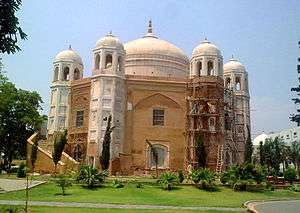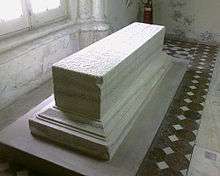Tomb of Anarkali
The Tomb of Anarkali (Urdu: مقبره انارکلی) is an octagonal 16th century Mughal monument in Lahore, capital of the Pakistani province of Punjab.
| مقبرہ انارکلی | |
 | |
Location in Lahore  Tomb of Anarkali (Pakistan) | |
| Coordinates | 31°34′43″N 74°21′50″E |
|---|---|
| Location | Lahore, Punjab
|
| Type | Mausoleum |
| Material | brick |
| Completion date | 1599 C.E., or 1615 C.E. |
| Dedicated to | Either Sahib-i-Jamal Begum, or Anarkali |
Background
The tomb of Anarkali is located on the grounds of Lahore's Punjab Civil Secretariat complex near the British-era Mall, southwest of the Walled City of Lahore. It is considered to be one of the earliest Mughal tombs still in existence, and is considered to be one of the most significant buildings of the early Mughal period.[1] The building is currently used as the Punjab Archives, and public access is limited.
History
Construction of the tomb dates to either 1599 C.E., or 1615 C.E.[2]
The tomb was said to be built by the Mughal Emperor Jehangir for his love Anarkali, as per legend, was caught by Emperor Akbar for exchanging glances with Jehangir, at the time known as Prince Saleem. Anarkali was reportedly a concubine of Emperor Akbar, and this action reportedly enraged the Emperor Akbar so much, that he had Anarkali interred alive in a wall. When Prince Saleem ascended the throne and took the name "Jehangir," he is reported to have ordered the construction of a tomb over the site of the wall in which Anarkali was reportedly buried.[2]
Eighteenth-century historian Abdullah Chagatai reported that the tomb was not the resting place for Anarkali, but instead for Jehangir's beloved wife Sahib-i-Jamal Begum.[2] Many modern historians accept the credulity of this account.[1] The building is currently used as the Punjab Archives, so access to the public is limited.
During the time of the Sikh Empire, the tomb was occupied by Kharak Singh,[3] and later was further desecrated by its conversion into the residence for the wife of General Jean-Baptiste Ventura, who was employed in the army of Ranjit Singh.[1] The tomb was then converted during the British Raj into clerical offices in 1847 before repurposing the tomb into the Anglican St. James Church in 1851, and later regarded as Lahore's "Protestant Cathedral."[4] In 1891, the church congregation was relocated, and the tomb was repurposed as the Punjab Record Office.[1]
The occupant's cenotaph was removed when the tomb was repurposed into a church. When the building no longer served as a church, the cenotaph was placed at the site of the former altar, and not at the original site of the cenotaph.[1]
Architecture
The structure's foundation are in the basic shape of an octagon, with alternating measurements of 44 feet and 30 feet for each side with semi-octagonal towers at each corner. The structure is also topped by a double-dome, and is one of the earlier examples of such a dome from the Mughal era. The dome rests upon 8 arches, each measuring 12 feet 3 inches.[1]
The large arches in the sides of the building were once open in typical Mughal fashion, but were blocked off by the British.[3]
The building is today covered in whitewashing. It was reportedly once surrounded by a garden.[3] The building is currently used as the Punjab Archives, so access to the public is limited.[1]
Cenotaph

The white marble cenotaph features carvings with the 99 names of Allah, and was described by 19th-century historians as "one of the finest pieces of carving in the world."[5]
In addition to the 99 names of Allah, the cenotaph is inscribed with a Persian couplet written by the Emperor Jehangir which reads: "Ah! could I behold the face of my beloved once more, I would give thanks unto my God until the day of resurrection."[1]
Conservation
The tomb is listed on the Protected Heritage Monuments of the Archaeology Department of Punjab.[6]
References
- "Anarkali's Tomb". Lahore Sites. Retrieved 23 August 2016.
- "Legend: Anarkali: myth, mystery and history". Dawn. 11 February 2012. Retrieved 23 August 2016.
- "Anarkali's Tomb". Asian Historical Architecture. Retrieved 24 August 2016.
- Glover, William (January 2007). Making Lahore Modern, Constructing and Imagining a Colonial City. Univ Of Minnesota Press. ISBN 978-0816650224.
What is more striking than the fact that the Punjab’s new rulers (cost-effectively) appropriated the symbolically charged buildings of their predecessors is how long some of those appropriations lasted. The conversion of the Mughal-era tomb of Sharif un-Nissa, a noblewoman during Shah Jahan’s reign, popularly known as Anarkali, was one such case (Figure 1.2). This Muslim tomb was first used as offices and residences for the clerical staff of Punjab’s governing board. In 1851, however, the tomb was converted into the Anglican church
- Eastwick, Edward Backhouse (1883). Handbook of the Punjab, Western Rajputana, Kashmir, and Upper Sindh. London: John Murray, Albemarle Street.
- Pakistan Environmental Protection Agency. "Guidelines for Critical and Sensitive Areas" (PDF). Government of Pakistan. pp. 12, 47, 48. Archived from the original (PDF) on 14 October 2013. Retrieved 6 June 2013.
| Wikimedia Commons has media related to Tomb of Anarkali. |